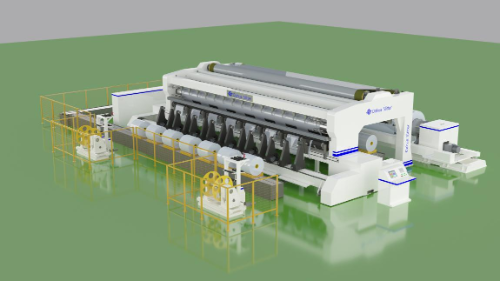
Slitting machines, like many industrial machines, involve rotating parts, sharp edges, and high-speed operations that can pose significant safety risks to operators. To prevent accidents caused by pinch points, rotating parts, or sharp edges, slitting machines incorporate a variety of safety features and design principles. Below is a detailed explanation of how these risks are mitigated:
Safety Guards
Enclosures: Slitting machines are often equipped with physical guards or enclosures that cover moving parts, such as the unwind stand, slitting knives, and rewind spindles. These guards prevent operators from coming into contact with hazardous areas.
Transparent Shields: Transparent polycarbonate or acrylic shields are used in some areas to allow visibility while maintaining safety.
Interlocking Guards: Some guards are interlocked with the machine's control system, meaning the machine will automatically shut down if the guard is opened or removed during operation.
Emergency Stop Systems
E-Stop Buttons: Easily accessible emergency stop (E-stop) buttons are installed at multiple locations on the machine. Pressing any E-stop button immediately halts all machine operations.
Foot Pedals: In some cases, foot-operated emergency stop pedals are provided for quick access without requiring the operator to reach for a button.
Safety Sensors and Proximity Detection
Photoelectric Sensors: These sensors detect when an operator's hand or body part enters a dangerous area near the machine. If triggered, the machine stops instantly.
Proximity Sensors: Used to monitor the distance between the operator and moving parts, these sensors can slow or stop the machine if the operator gets too close.
Light Curtains: A grid of infrared beams creates a "light curtain" around hazardous areas. Breaking the beam triggers an immediate shutdown.
Speed Control and Slow-Down Features
Variable Speed Control: Many slitting machines allow operators to adjust the speed of operation based on the task. Lower speeds reduce the risk of accidents during setup or maintenance.
Slow-Down Zones: Machines may be programmed to automatically reduce speed in areas where operators need to interact closely with the material or machine components.
Blade Safety Features
Blade Covers: Sharp cutting blades are typically covered with protective shrouds or shields to prevent accidental contact.
Retractable Blades: Some machines use retractable or guarded blades that only expose the cutting edge during operation.
Blunt Edges on Non-Cutting Surfaces: Non-functional surfaces of the blades are designed to be blunt or rounded to minimize injury risk.

Material Handling Systems
Automated Feeding and Unwinding: Automated systems for feeding material into the machine and unwinding rolls reduce the need for manual intervention, thereby minimizing exposure to pinch points.
Guided Pathways: Materials are often guided through the machine using rollers or tracks that keep them away from hazardous areas.
Operator Training and Awareness
Comprehensive Training Programs: Operators are trained on the proper use of the machine, including understanding safety protocols, recognizing hazards, and performing routine maintenance safely.
Warning Labels and Signage: Clear warning labels are placed on the machine to highlight potential dangers, such as pinch points, rotating parts, and sharp edges.
Personal Protective Equipment (PPE): Operators are required to wear appropriate PPE, such as gloves, safety glasses, and hearing protection, depending on the application.
Maintenance and Inspection Protocols
Regular Inspections: Scheduled inspections ensure that all safety features, such as guards and sensors, are functioning correctly.
Lockout/Tagout Procedures (LOTO): Before performing maintenance or repairs, the machine is locked out and tagged to prevent accidental startup.
Blade Replacement Protocols: Specialized tools and procedures are used to replace blades safely, minimizing the risk of cuts or injuries.
Compliance with Standards
Industry Regulations: Slitting machines are designed to comply with safety standards such as OSHA (Occupational Safety and Health Administration) in the U.S., CE marking in Europe, or ISO (International Organization for Standardization) standards globally.
Certifications: Machines may undergo third-party testing and certification to ensure they meet rigorous safety requirements.
Advanced Technologies
Condition Monitoring: Modern slitting machines may include condition monitoring systems that detect abnormalities in machine performance, such as misalignment or excessive vibration, which could lead to unsafe conditions.
Predictive Maintenance: Using IoT (Internet of Things) sensors, machines can predict when components might fail, allowing for proactive maintenance and reducing the likelihood of accidents.